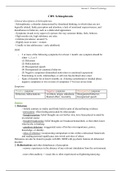Interim 2: Clinical Psychology
CH9: Schizophrenia
Clinical descriptions of Schizophrenia
- Schizophrenia: a disorder characterized by disordered thinking, in which ideas are not
logically related; faulty perception and attention; a lack of emotional expressiveness; and
disturbances in behavior, such as a disheveled appearance.
- Symptoms invade every aspect of a person: the way someone thinks, feels, behaves.
- High suicide rate, high substance use rates.
- Lifetime prevalence: around 1%.
- Slightly more in men > women.
- Usually in late adolescence / early adulthood.
DSM
- 2 or more of the following symptoms for at least 1 month: one symptom should be
either 1, 2, or 3:
(1) Delusions
(2) Hallucinations
(3) Disorganized speech
(4) Disorganized (or catatonic) behavior
(5) Negative symptoms (diminished motivation or emotional expression)
- Functioning in work, relationships, or self-care has declined since onset
- Signs of disorder for at least 6 months; or, if during a prodromal or residual phase,
negative symptoms or two or more of symptoms 1-4 in less severe form
Symptoms
Positive symptoms Negative symptoms Disorganized symptoms
Delusions, hallucinations Avolition, alogia, anhedonia, Disorganized behavior,
blunted affect, Asociality disorganized speech
Positive
1) Delusions
= beliefs contrary to reality and firmly held in spite of disconfirming evidence.
- persecutory: when feeling persecuted by other people
- thought insertion: belief thoughts are not his/her own, have been placed in mind by
an external source
- thought broadcasting: belief thoughts are broadcast/transmitted, so that others know
what he/she is thinking
- grandiose delusions: exaggerated sense of his/her own importance, power,
knowledge, or identity.
- ideas of reference: incorporating unimportant events within a delusional framework
and reading personal significance into trivial activities of others
Delusions can also be found in people with BD, MDD with psychotic features & delusional
disorder.
2) Hallucinations and other disturbances of perception
- sensory experiences in the absence of any relevant stimulation from the environment.
- more often auditory > visual, this is often experienced as frightening/annoying.
, Interim 2: Clinical Psychology
might be due to problem in connections frontal lobe areas that enable the
production of speech + temporal lobe areas that enable speech understanding.
Negative
- Avolition
= lack of motivation and a seeming absence of interest or an inability to persist in what are
usually routine activities, incl. work, school, hobbies, social activities.
research indicates this may only be in some life areas, and not others.
- Asociality
= severe impairments social relationships.
- Anhedonia
= Loss of interest or reported lessening in experience of pleasure.
2 types of pleasure experiences:
1) consummatory pleasure: amount of pleasure experienced in the moment or in the presence
of something pleasurable.
2) anticipatory pleasure: amount of expected or anticipated pleasure from future events or
activities.
people with schizophrenia seem to have deficit in anticipatory pleasure and not in
consummatory pleasure.
- Blunted affect
= lack of outward expression or emotion. Only outward, not person’s inner experience of
emotion.
- Alogia
= reduction in amount of speech.
- First 3: motivation and pleasure domain. Last 2: expression domain.
Disorganized
- Disorganized speech
= problems in organizing ideas and in speaking so that a listener can understand.
loose associations/derailment: more successful in communication, but difficulty
sticking to one topic.
this does not have to do with problems in language production, the problem is in
executive functioning.
- Disorganized behavior
= seem to lose ability to organize behavior and make it conform to community standards.
- catatonia: may gesture repeatedly, using peculiar and sometimes complex sequences
of finger, hand, arm movements, which often seem to be purposeful. Not that often
seen in schizophrenia anymore.
Schizophrenia and the DSM-5
- Symptoms at least 6 months
- 6 month-period at least 1 month of an acute episode/active phase, defined by presence
of 2 (+) of the following:
o Delusions
o Hallucinations
, Interim 2: Clinical Psychology
o Disorganized speech
o Disorganized behavior
o Negative symptoms
Other psychotic disorders
- Schizophreniform disorder
same as schizophrenia, but the symptoms last for 1 to 6 months
- Brief psychotic disorder
1 day to 1 month, often brought on by extreme stress.
- Schizoaffective disorder
mixture of symptoms of schizophrenia and mood disorders. DSM: depressive/manic episode
required.
- Delusional disorder
troubled by persistent delusions.
Etiology of schizophrenia
- Genetic factors
Genetically heterogenous (= vary from case to case)
Gene-environment interaction studies
o Behavior genetics research
family, twin, and adoption studies support genetic factors role
Family studies
the closer the genetic relationship, the bigger the risk
this supports genetic component, but families also often have common
experiences, environment can’t be discounted
Twin studies
Not 100%(it’s 44.3%) in MZ twins, this means that it’s not only the
genetic transmission alone that accounts for schizophrenia.
Children of the MZ twin without Schizophrenia almost as high rate as
the children of MZ twin with Schizophrenia. support genetic
component (not expressed in MZ twin without Schizophrenia)
Adoption studies
Higher risk for developing schizophrenia among adopted children from
schizophrenic parent(s) than adopted children without schizophrenic
parent(s).
Familial high-risk studies
begins with 1-2 biological parents with schizophrenia and follows their
offspring longitudinally in order to identify how many of the children
may develop schizophrenia and what types of childhood
neurobiological and behavioral factors predict the disorder’s onset.
o Molecular genetics research
Multiple genes associated with schizophrenia and BPD.
Different genes are found
Postmortem studies also found that there is less dysbindin in a number
of brain areas of people with schizophrenia







